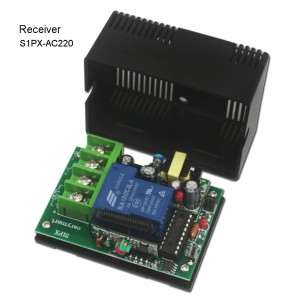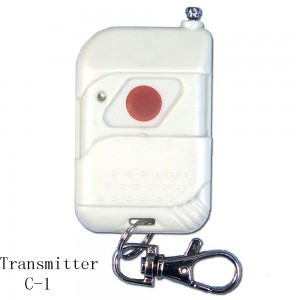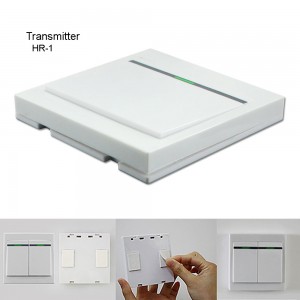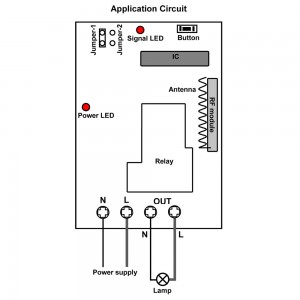The general RF wireless control system uses a remote controller or transmitter to control the device connected to a wireless receiver. However, for some special occasions, we need to use dry contacts (normally open / normally close contacts) to wirelessly activate or control another remote device. Such as one of our customers wants to use a vibration sensor to remotely control an LED warning lamp.
The vibration sensor is a small device that can sense vibration. It has two normally open contacts which connected to two output lines. The vibration sensor can be mounted on a door, a window, or other objects to detect if the door or window is opened or to detect if the object has been moved. When the vibration sensor is stationary, its two output lines are disconnected. When the vibration sensor is vibrated or moved, the normally open contact is closed so that its two output lines are connected.

We recommend this customer to purchase a normally open contact wireless trigger system(Model 0020522). The system consists of a transmitter/remote control CB-2N (Model 0021045) and a wireless receiver S1X-DC12-ANT3 (Model 0020490). The transmitter CB-2N can be triggered by a normally open dry contact. It has two input lines, and they are normally open. When these two lines are connected, the transmitter is triggered and emits an “ON” wireless signal. When the two lines are disconnected, the transmitter is triggered again and emits another “OFF” wireless signal. The receiver S1X-DC12-ANT3 is a DC 12V input/output type, maximum operating current is 10A, it has a waterproof case and an external rod antenna, so it can be installed outdoors. This kit of normally open contact wireless triggering warning system can achieve a working distance of up to 1000 meters in the open area.

Normally open contact wireless trigger system
The example diagram and detailed operation of this wireless trigger system are as follows:
The customer first connects the two output lines of the vibration sensor to the two input lines of the transmitter CB-2N, and then connects the DC 12V power adapter to the wireless receiver S1X-DC12-ANT3 and connects the LED warning lamp to the receiver’s output terminals.
When the vibration sensor is vibrated or moved, its normally open contact is closed and the two output lines are connected. The transmitter CB-2N is triggered at the same time and transmits a wireless signal “ON” to the remote receiver. When the receiver S1X-DC12-ANT3 receives this wireless signal, it outputs a DC 12V power supply to turn on the LED warning lamp. Of course, the customer can also use the buttons on the remote control to turn off or turn on the LED warning lamp connected to the receiver.
This kit of normally open contact wireless triggering devices mainly uses a device with a normally open / normally closed output to wireless control another AC or DC device. This system consists of a transmitter/remote control and a receiver. The transmitter can be connected to a variety of devices that have normally open / normally closed outputs, such as warning host, cable detectors, various sensors, limit switches, Programmable Logic Controllers and so on. The receiver can be used to connect a variety of DC / AC devices, such as warning horns, lights, motors, electric machinery, electric doors and so on. This system can be used in many applications such as water level control of the tank, automatic remote control of industrial equipment, and synchronous wireless control of agricultural equipment and so on.
We offer two types of transmitters: CB-2N (Model 0021045) and CB-2N-2 (Model 0021046).
We offer three types of receivers.
- DC power output type receivers, such as receivers S1X-DC12-ANT3 (Model 0020490) and S1PX-DC12-ANT2 (Model 0020438), which are commonly used to control DC devices.
- AC power output type receivers, such as receivers S1X-AC220-ANT3 (Model 0020393) and S1PX-AC220-ANT2 (Model 0020442), which are commonly used to control AC devices.
- Relay (NO/NC) output type receivers, such as receivers S1U-DC12-ANT2 (Model 0020249), S1U-AC220-ANT3 (Model 0020466), S1PU-DC12-ANT3 (Model 0020302) and S1PU-AC220- ANT3 (Model 0020488). This relay type receiver is equivalent to a single pole double throw switch, its relay output has three output terminals (normally closed, normally open, common), they can be used to control a variety of DC / AC devices.
Transmitter CB-2N has two input lines, the working principle is as follows:
When the transmitter’s two input lines are connected, it automatically emits an “ON” wireless signal, which is equivalent to the function of the button “ON” on the transmitter.
When the transmitter’s two input lines are disconnected, it automatically emits an “OFF” wireless signal, which is equivalent to the function of the button “OFF” on the transmitter.
When the receiver receives the “ON” or “OFF” wireless signals, it will activate or deactivate its relay to turn on or turn off the connected devices.
Transmitter CB-2N-2 has three input lines, the working principle is as follows:
When the transmitter’s input lines 1 and input lines 3 are connected, it automatically emits an “ON” wireless signal, which is equivalent to the function of the button “ON” on the transmitter.
When the transmitter’s two input lines 2 and input lines 3 are disconnected, it automatically emits an “OFF” wireless signal, which is equivalent to the function of the button “OFF” on the transmitter.
When the receiver receives the “ON” or “OFF” wireless signals, it will activate or deactivate its relay to turn on or turn off the connected devices.
Attention:
The transmitter’s operating voltage is DC9V. It can work for about 3 days by using a model 6F22 9V battery. If you want to work long hours, we recommend using a model 6F22 9V rechargeable lithium battery or a DC9V power adapter.
 Follow
Follow


